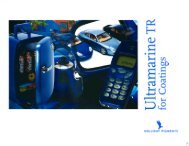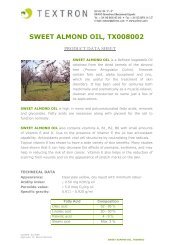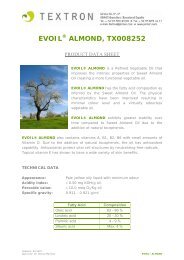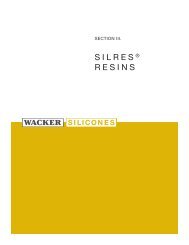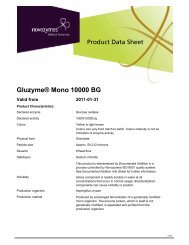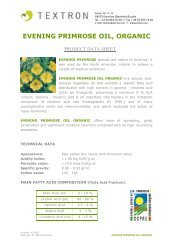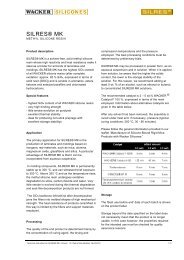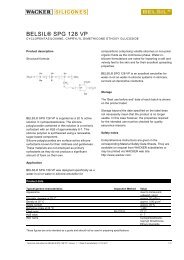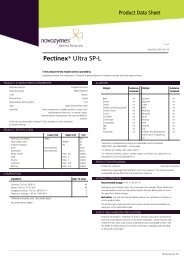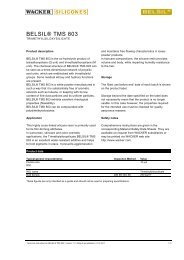Glossary of Terms - Paints and Coatings - Brenntag Specialties, Inc.
Glossary of Terms - Paints and Coatings - Brenntag Specialties, Inc.
Glossary of Terms - Paints and Coatings - Brenntag Specialties, Inc.
You also want an ePaper? Increase the reach of your titles
YUMPU automatically turns print PDFs into web optimized ePapers that Google loves.
<strong>and</strong> the limit is 20%. In addition, the sum <strong>of</strong> all three<br />
categories may not exceed 20% by volume. The rule,<br />
known originally as Rule 66 was promulgated in 1967<br />
in Los Angeles, CA, <strong>and</strong> is roughly based on smog<br />
chamber testing. Aromatics <strong>and</strong> branched ketones<br />
have been strongly affected by the Rule 66 approach.<br />
This definition is now contained in Rule 102 <strong>of</strong> the<br />
South Coast Air Quality Management District. The<br />
photochemically reactivity concept has been largely<br />
supplanted by the VOC concept in regulations.<br />
Prevention <strong>of</strong> Significant Deterioration (PSD):<br />
A program established to preserve air quality in areas<br />
already meeting the NAAQS.<br />
Proposition 65:<br />
Formerly known as the California Safe drinking Water<br />
<strong>and</strong> Toxic Enforcement Act, the act was voted in by<br />
California voters through the initiative process. The<br />
state establishes two lists, one <strong>of</strong> which contains<br />
compounds known to the state to cause cancer, while<br />
the other list contains compounds known to be<br />
fetotoxic. Labeling requirements were established to<br />
assure that anyone potentially exposed to compounds<br />
on the list is notified. Since an advisory committee<br />
periodically reviews the lists <strong>and</strong> adds compounds, the<br />
list is always changing.<br />
The Resource Conservation Recovery<br />
Act <strong>of</strong> 1976 (RCRA):<br />
Administered by the EPA, the act regulates the<br />
activities <strong>of</strong> generators, transporters <strong>and</strong> those who<br />
treat, store or dispose <strong>of</strong> hazardous wastes, <strong>and</strong><br />
provides “cradle to grave” authority to control<br />
hazardous wastes from their generation to their<br />
ultimate disposal. RCRA regulations establish criteria<br />
to identify which wastes are hazardous <strong>and</strong> in what<br />
quantities, concentrations, forms <strong>of</strong> disposal,<br />
monitoring hazardous waste sites <strong>and</strong> regulating<br />
underground storage tanks.<br />
Reasonability Available Control<br />
Technology (RACT):<br />
Technology required to be installed on existing major<br />
sources in attainment areas. RACT reflects controls<br />
EPA has identified in CTG’s or other guidance.<br />
Right-To-Know:<br />
OSHA enacted the Hazard Communication St<strong>and</strong>ard<br />
in 1985 to m<strong>and</strong>ate occupational hazard<br />
communications to employees. Both state <strong>and</strong> local<br />
laws pertaining to this subject are preempted by federal<br />
st<strong>and</strong>ard, unless a federally approved state plan is in<br />
effect.<br />
Glossaries<br />
MINERALS COLORS CHEMICALS ADDITIVES RESINS EQUIPMENT<br />
12<br />
SARA Title lll:<br />
The main requirements for Title lll (the Emergency<br />
Planning <strong>and</strong> Community Right-To-Know Act) <strong>of</strong> the<br />
Superfund Amendments <strong>and</strong> Reauthorization Act<br />
(SARA) involve sections governing Extremely<br />
Hazardous Substances, CERCLA hazardous<br />
substances, the Toxic Release Inventory <strong>and</strong> MSDS<br />
categories.<br />
*SARA Section 302 - Threshold planning quantity <strong>of</strong><br />
Extremely Hazardous Substance for emergence<br />
<strong>and</strong> notification.<br />
*SARA Section 304 - This section lists the CERCLA<br />
hazardous substance subject to emergency release<br />
notification.<br />
*SARA Section 311/312 - Delineates health <strong>and</strong><br />
physical hazard categories for MSDS Reporting.<br />
*SARA Section 313 - The Toxics Release Inventory<br />
(TRI). Facilities that h<strong>and</strong>le chemicals designated in<br />
the TRI must complete a toxic chemical release<br />
form annually detailing releases during the<br />
preceding calendar year. These releases may be<br />
allowed under air or water permits, may be spills <strong>of</strong><br />
waste or product<br />
materials or may be fugitive emissions. The<br />
reporting threshold for 1989 <strong>and</strong> thereafter is 25,000<br />
pounds. A de minimis limit applies to toxic<br />
chemicals present in concentrations below 1%, or<br />
0.1% if the chemical is a<br />
carcinogen. The TRI is placed in a database open<br />
to the public. Environmental groups use TRI<br />
information to put pressure on industrial firms to<br />
reduce their emissions.<br />
South Coast Air Quality Management<br />
District (SCAQMD):<br />
The air pollution control body established in Southern<br />
California. SCAQMD governs air pollution control<br />
efforts in Los Angeles County, Orange County,<br />
Riverside County <strong>and</strong> San Bernardino County.<br />
State Implementation Plans (SIP’s):<br />
Plans that each state must develop to provide for<br />
attainment <strong>and</strong> maintenance <strong>of</strong> the NAAQS’s.<br />
Theshold Limit Value (TLV):<br />
The American Conference <strong>of</strong> Governmental <strong>and</strong><br />
Industrial Hygienists reviewed several hundred existing<br />
chemicals in order to provide industrial hygienists with<br />
an evaluation <strong>of</strong> health hazards in the workplace. The<br />
TLV is the limit believed by the ACGIH to which nearly<br />
all workers may be repeatedly exposed day after day<br />
without adverse affects. The airborne concentration is<br />
expressed as TLV/TWA or TLV/STEL (Short Term<br />
Exposure Limit).




